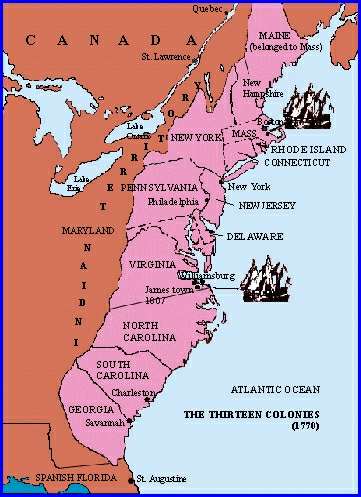| PinkMonkey Study Guide - American
History
2. 3 Puritan Influence on the Early American
Society
Early in his reign, Charles I wanted to get Puritans
to settle in America. This he did by offering them generous grants
for settlement in America. One such grant went to a group of puritans
to settle in the Islands of West Indies. Another grant went to the
Massachusetts Bay Company. The king also gave a charter to George
Calvert to establish a colony in Virginia, where Roman Catholics
were permitted to settle.
The Massachusetts Bay Company organized a group
of rich Puritans, and landed in what is now known as New England.
The Members had signed an Agreement - the Cambridge Agreement, to
settle with their families in the New World. It is interesting to
note that nowhere in the Charters or agreements signed is there
a mention made of a government or headquarters for the colonies.
The settlements that came up in the New World, due to practical
needs, created self-government with the consent of the settlers.
For instance, the Massachusetts Company elected
John Winthrop as its governor. With time, as the settlement grew
in population, the company formed a government to conduct the business
of the company. Winthrop, the governor of the company, became the
governor of the colony.
Initially, when the colony was just set up, the puritan values of
self-denial, discipline and hard work helped the settlers establish
their colony. The Puritan government not only looked after the affairs
of the company but also of the colony. It enacted into law the biblical
injunctions against drunkenness, adultery, murder, and theft in
an attempt to regulate the religion and morality of the people.
The colony was not a theocracy i.e. it was not
run by the church. Thus the Puritan colony in the 17th century was
not just a dull, pleasure denying society. The colony was involved
in profitable trade, and had developed a lively social life where
alcohol was consumed. Educated puritans read secular as well as
religious literature. This was the basic difference between the
Puritanism in England and the Puritanical values that developed
in the New World.
However, the formal separation of the church from
the state had not occurred yet. In both New England and the south,
there was a union of church and state. In other words, the church
was supported by the state. In fact, church attendance increased
during the ’witch craft trials’ at Salem (1690 - 92). The period
saw more than 150 people imprisoned and several women were publicly
burned at stakes. Membership of the church was essential for voting
or holding any public office.
By 1733, the British had set up a total of 13 colonies
in North America.
(See Appendix.)
The Colonies

Click Here for Enlargement
Exhibit 2.2
Before the first Europeans touched the shores of
North America, the Red Indians already inhabited the New World.
They lived in tribes, some of them were nomadic, while the others
led a settled life doing agriculture on vast pieces of land. Initially,
the Indians in North America accepted the Europeans settlers in
their midst. Some Indians helped the white men adjust in their new
environment. However, very often conflicts broke out between the
Indians and the Europeans. This was chiefly due to the European
adventurers who tried to grab the lands of the Indians.
[Next Page]
|